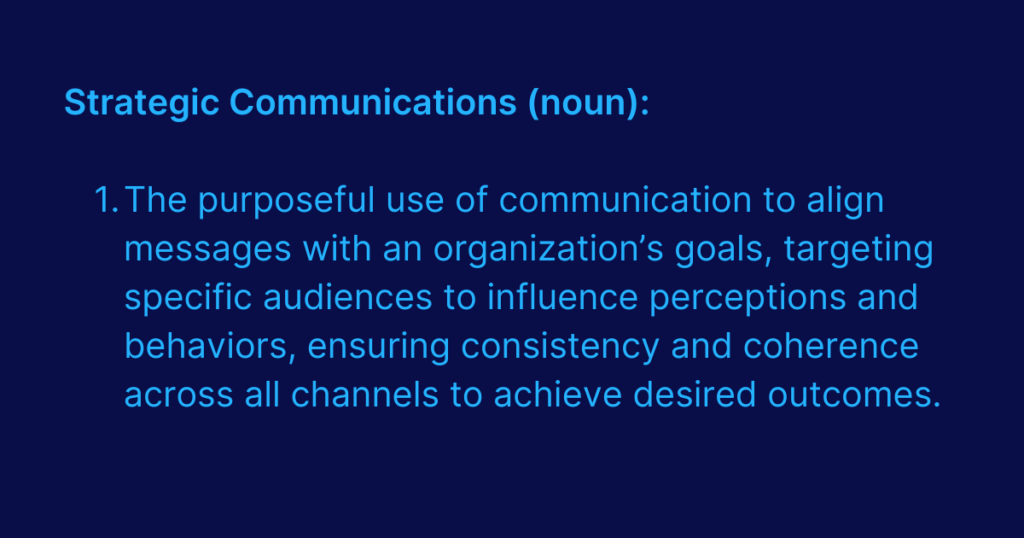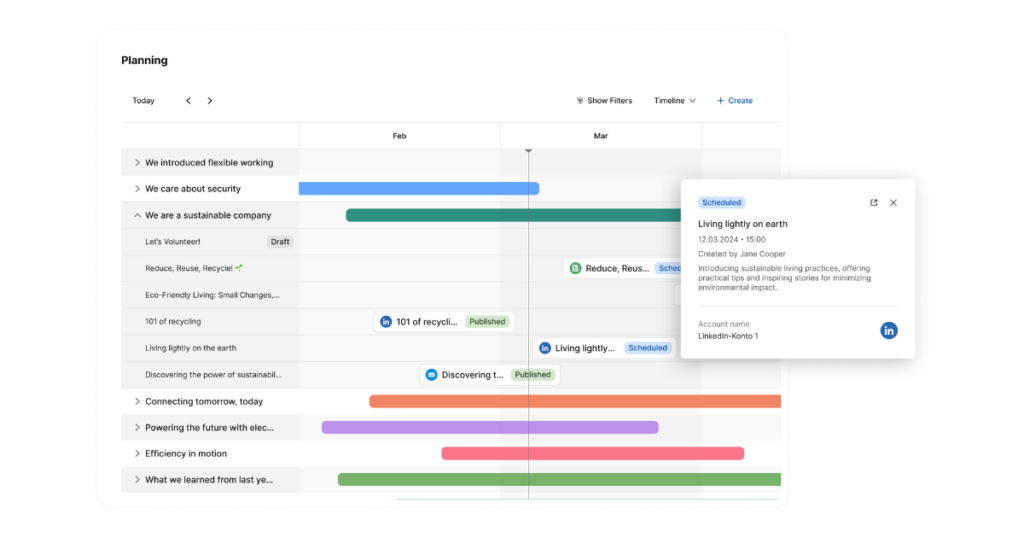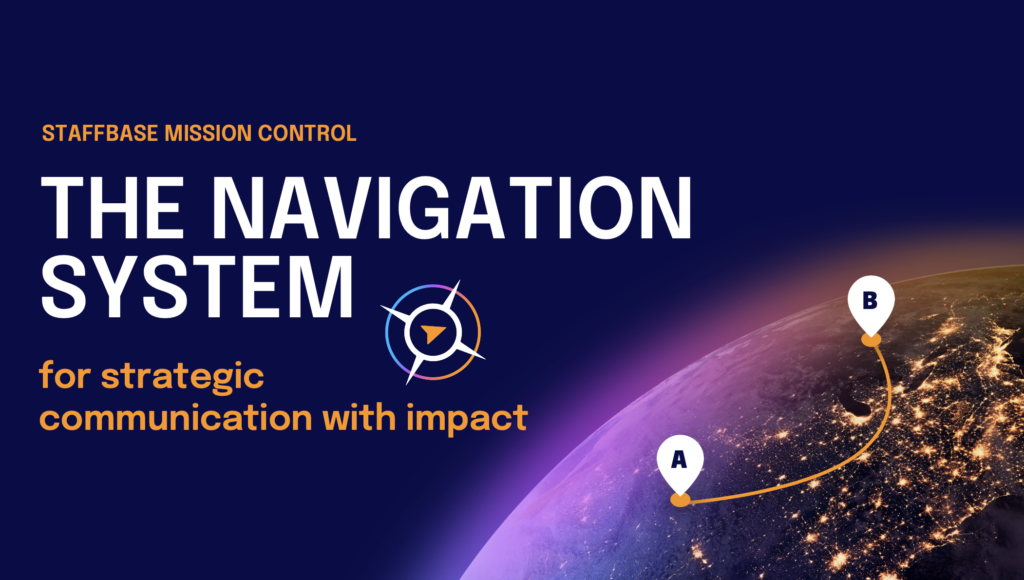Understanding Strategic Communications: Its Definition, Importance, and Planning
Discover how strategic communication aligns organizational goals, enhances brand reputation, and drives engagement through effective, cohesive messaging strategies.

Definition of strategic communication
Strategic communications is the purposeful use of communication by an organization to fulfill its mission. It involves the development and delivery of messages that align with the organization’s goals and values, targeting specific audiences to influence their perceptions and behaviors. This approach integrates various communication disciplines including public relations, marketing, and organizational communication both internal and external to ensure consistency and coherence in messaging across all channels.
What defines strategic communications is careful planning, execution, and evaluation, allowing it to effectively reach and engage stakeholders, support decision-making, and achieve desired outcomes. It is a proactive process that anticipates challenges and opportunities, fostering a positive organizational image and building strong relationships with key audiences.

What is strategic communication?
If you don’t know where you’re going, you’ll end up someplace else.”
Yogi Berra
In the context of modern enterprise organizations, strategic communications involves leveraging digital tools and platforms to effectively convey the organization’s mission, values, and goals to internal and external stakeholders alike. This approach integrates digital marketing communication, social media, content creation, and data analytics to create cohesive and impactful messaging.
Strategic communications in this setting prioritize real-time engagement, personalized content, and multi-channel distribution to reach a diverse and geographically dispersed audience. It also involves monitoring digital trends and feedback to adapt strategies swiftly and maintain relevance.
Ultimately, strategic communications in enterprise organizations aim to build strong brand identities, foster employee engagement, enhance customer relationships, and drive business growth through a coordinated and data-driven communication strategy.
Why strategic communication is important for your company
Strategic communication is crucial for companies as it aligns all corporate communication efforts with the overall business strategy, ensuring that you’re communicating the best message for contributing to the organization’s goals. This coherence enhances the brand image, builds trust, and establishes a clear, consistent identity in the market. Effective strategic communication also enables companies to navigate crises efficiently, maintaining stakeholder confidence and minimizing reputational damage.
The pros of a sound comms strategy
There are notable examples of companies benefiting or failing due to the presence or absence of a robust internal communications plan. Amazon, for instance, uses targeted, concise internal communications to keep its vast workforce informed and engaged, delivering information in short, digestible formats to ensure employees receive and understand necessary updates without feeling overwhelmed. Similarly, 3M’s strategy supports innovation by allowing employees time for creative projects, utilizing effective communication tools to foster collaboration and idea generation.
When GE spun off into three new global, public, and industry-leading companies, the company knew it needed a more agile and targeted way to get communications out and to engage with employees. They created a new comms strategy centered on a contemporary and more seamless user experience for both employees and the communications team members. To enable their improved comms and to give employees a better UX, they decided on a do-it-all, multichannel internal comms strategy featuring a single platform solution with a powerful metrics dashboard.
The cons of failing to strategize your comms
Conversely, the absence of a coherent internal communication plan has led to significant failures. Yahoo, under CEO Marissa Mayer, experienced high employee dissatisfaction and turnover partly due to poor communication strategies that resulted in confusion and mistrust. Uber also faced substantial challenges during its crisis involving workplace culture and sexual harassment allegations, where inadequate internal communication exacerbated the situation, damaging the company’s reputation and eroding trust among employees and the public. This failure ultimately led the company to pay a $4.4 million settlement.
Examples like these highlight the critical role of a well-structured internal communications plan in driving long-term engagement, innovation, and overall organizational success, while poor communication can lead to severe operational, reputational, and financial damages.
"Effective communication gets you heard, but strategic communication gets you understood and remembered."
Brian Tomlinson, Head of Content, Staffbase
The following ten benefits of successful strategic communications can help to create a work environment where employees feel valued, informed, and integral to the company’s success, leading to higher productivity and overall organizational effectiveness.
Increased engagement
Strategic communication increases employee engagement benefits by fostering a clear, consistent, and transparent flow of information, which helps employees feel informed and valued. It also creates opportunities for two-way communication, allowing employees to voice their opinions and feel heard, thereby boosting their sense of involvement and commitment. Additionally, aligning communication with the organization’s goals and values reinforces a shared purpose and motivates employees to contribute more actively to achieving collective objectives.
Clarity and transparency
Strategic communication enhances clarity and transparency within an organization, leading to better understanding and alignment of goals and expectations among employees. This openness fosters trust and reduces uncertainties, enabling employees to make better-informed decisions and collaborate more effectively. Ultimately, clear and transparent communication cultivates a culture of honesty and accountability, which strengthens overall organizational integrity and performance.
Motivation and morale
Strategic communication significantly boosts motivation and morale by ensuring employees feel valued, informed, and connected to the organization’s mission and goals. Regular, transparent updates and recognition of achievements make employees feel appreciated and integral to the organization’s success. This sense of inclusion and appreciation enhances job satisfaction, driving higher levels of motivation and overall morale.
Collaboration and teamwork
Strategic communication enhances collaboration and teamwork by promoting clear, consistent, and open channels of communication among team members. By articulating shared goals and expectations, it ensures everyone is aligned and working towards common objectives. This clarity reduces misunderstandings and fosters a cooperative environment, where team members feel more comfortable sharing ideas, providing feedback, and supporting one another to achieve collective success.
Alignment with goals
Strategic communication ensures alignment with organizational goals by clearly articulating the mission, vision, and objectives to all employees. This clarity helps individuals understand how their roles contribute to overall success, fostering a sense of direction and purpose. Regular updates and consistent messaging keep everyone focused and aligned, facilitating coordinated efforts and maximizing the achievement of organizational goals.
Crisis management
Strategic communication significantly improves crisis management by ensuring the timely and accurate dissemination of information to all stakeholders, thereby controlling the narrative and minimizing the spread of misinformation. It helps maintain trust and credibility by transparently communicating how the organization is addressing the crisis, which demonstrates responsibility and accountability. Additionally, strategic communication provides a framework for consistent updates, keeping stakeholders informed about ongoing developments and the organization’s responses, helping to mitigate panic and foster cooperation.
Brand reputation
Strategic communication enhances brand reputation by consistently conveying the organization’s values, mission, and successes to internal and external audiences. This consistency helps build and maintain public trust and positive perception, making the brand more resilient to negative events and more attractive to customers and partners. Additionally, strategic communication ensures that the organization’s messaging is coherent and aligned across all channels, reinforcing a strong, unified brand identity that resonates with stakeholders.
Employee retention
Strategic communication plays a vital role in employee retention by fostering a positive work environment where employees feel informed, valued, and connected to the organization’s mission and goals. Regular and transparent communication helps employees understand their roles and contributions, which enhances their sense of belonging and job satisfaction. Additionally, strategic communication facilitates the recognition of employee achievements and provides platforms for feedback and dialogue, further boosting morale and commitment to the organization.
Customer relationships
Strategic communication strengthens customer relationships by ensuring consistent and clear messaging across all touchpoints, which builds trust and reinforces brand loyalty. By keeping customers well-informed and engaged with timely updates, personalized content, and transparent communication, companies can enhance customer satisfaction and retention. Furthermore, strategic communication allows for effective feedback loops, enabling organizations to understand and respond to customer needs and concerns promptly, thereby fostering a stronger, more responsive relationship with their customer base.
Innovation
Strategic communication promotes innovation by creating an open environment where ideas can be freely shared and discussed. This openness encourages collaboration and creative problem-solving among employees, leading to the generation of new ideas and approaches. Facilitating clear and consistent communication ensures that innovative ideas are aligned with the organization’s goals and can be effectively implemented. Additionally, strategic communication tools and platforms enable the efficient exchange of knowledge and feedback, further driving a culture of continuous improvement and innovation.
How to write a strategic communications plan
Having a written strategic communications plan is essential for any organization. It serves as a comprehensive roadmap that outlines the communication goals, target audiences, key messages, tactics, and evaluation methods.
A written plan ensures consistency and coherence in messaging across all channels and departments, aligning communication efforts with the organization’s overarching objectives. It also provides clear guidelines and a structured approach, enabling proactive and reactive communication management. Furthermore, a documented internal communications plan facilitates better resource allocation and accountability by delineating roles and responsibilities.
Ultimately, strategic communications programs will help organizations navigate both routine and crisis situations more effectively, ensuring that all stakeholders are well-informed and engaged.
Writing a good strategic communications plan involves several key steps to ensure that your communication efforts align with your organization’s goals and effectively reach your target audiences.
Here’s a ten-step approach:
1. Executive summary
Provide a brief overview of the strategic communications plan.
Outline the key objectives, target audiences, and expected outcomes.
2. Goals and objectives
Define clear, measurable goals that align with the organization’s mission and strategic objectives.
Set SMART objectives (Specific, Measurable, Achievable, Relevant, Time-bound) for your communication efforts.
3. Situational analysis
Conduct a SWOT analysis (Strengths, Weaknesses, Opportunities, Threats) to understand the current communication landscape.
Analyze internal and external factors that may impact your communication strategy.
4. Target audience
Identify and segment your key audiences (e.g., employees, customers, investors, media, community).
Understand their needs, preferences, and the communication channels they use.
5. Key messages
Develop core messages that you want to convey to each target audience.
Ensure that these messages align with your organization’s values and objectives.
6. Communication channels
Select the most effective channels for reaching each target audience (e.g., email, social media, press releases, internal portals, events).
Consider the strengths and limitations of each channel.
7. Tactics and activities
Outline specific communication activities and initiatives to deliver your key messages (e.g., campaigns, newsletters, webinars, press conferences).
Assign timelines, responsibilities, and resources for each activity.
8. Budget
Estimate the costs associated with your communication activities.
Allocate the budget for different channels, tools, and resources.
9. Implementation plan
Develop a detailed action plan with timelines, milestones, and responsible parties.
Ensure coordination and collaboration among team members.
10. Evaluation and adjustment
Define key performance indicators (KPIs) to measure the effectiveness of your communication efforts (e.g., engagement rates, media coverage, employee feedback).
Establish a process for regular monitoring, evaluation, and reporting.
Be prepared to make adjustments based on feedback, changing circumstances, and performance data.
Sample strategic communications plan template
1. Executive Summary
• Overview: A summary of the plan’s purpose and key elements.
• Goals: Align communication with company mission and objectives.
• Key Messages: Main themes to convey.
2. Goals and Objectives
• Goal: Improve internal communication to enhance employee engagement.
• Objective: Increase employee newsletter open rates by 20% in the next 6 months.
3. Situational Analysis
• Strengths: Strong brand reputation.
• Weaknesses: Limited internal communication channels.
• Opportunities: Growing social media presence.
• Threats: Competitive market environment.
4. Target Audience
• Employees: All levels within the organization.
• Customers: Existing and potential.
• Investors: Current and prospective.
5. Key Messages
• To Employees: “Your role is vital to our success.”
• To Customers: “We are committed to your satisfaction.”
6. Communication Channels
• Internal: Intranet, email newsletters, town hall meetings.
• External: Social media, press releases, company website.
7. Tactics and Activities
• Employee Newsletter: Monthly updates on company news and employee achievements.
• Social Media Campaign: Weekly posts highlighting product features.
8. Budget
• Newsletter: $500/month.
• Social Media Ads: $1000/month.
9. Implementation Plan
• Timeline: Monthly newsletter starting August 1.
• Responsibility: Communications team and department heads.
10. Evaluation and Adjustment
• KPI: Newsletter open rate, social media engagement.
• Evaluation: Quarterly review meetings.
• Adjustments: Based on performance metrics and feedback.
By following the ten steps outlined in this template, you can create a strategic communications plan that is well-organized, targeted, and effective in achieving your communication goals.
Tools and software for strategic communication
Strategic communication in modern enterprises requires the right set of tools and software to effectively reach and engage target audiences. These tools help streamline communication processes, ensure message consistency, and measure the impact of communication efforts.
Key tools include:
Intranet platforms like Staffbase that facilitate internal communication and collaboration enable employees to stay informed and connected.
Email marketing software is essential for reaching external audiences with targeted campaigns.
Social media publishing tools help manage and schedule posts across various platforms, ensuring a cohesive social media presence. There is a great variety of solutions on the market for different use cases and company sizes. To plan, publish, and measure all your communications across internal and external channels you can use holistic solutions like Staffbase Mission Control.
Analytics tools such as Google Analytics or HubSpot provide insights into audience engagement and the effectiveness of communication strategies.
Project management software like Asana or Trello ensures that communication plans are executed efficiently, with clear timelines and responsibilities.
 Strategic comms planning with Mission Control
Strategic comms planning with Mission Control
By leveraging these tools, organizations can enhance their strategic communication efforts, ensuring that their messages are delivered effectively and resonate with their intended audiences.










